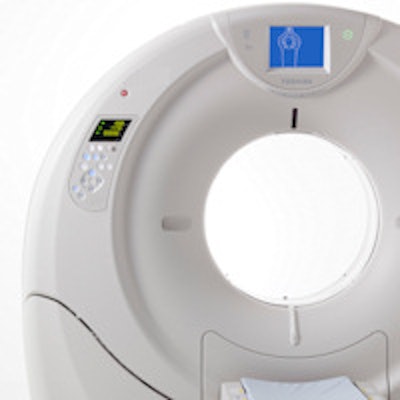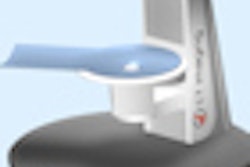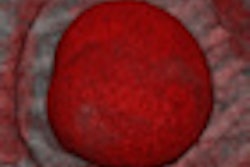
Sometimes you don't find what you're looking for -- you find more. Research shows body CT finds breast abnormalities, so it's important to be able to distinguish between benign and malignant features.
The greater use of CT has resulted in more detection of incidental breast lesions unrelated to the primary diagnostic inquiry. It is important to have knowledge of imaging features that help in categorizing these lesions into those demonstrating benign features and those showing malignant features, thereby guiding appropriate patient management, according to researchers from the University Hospital of North Staffordshire, National Health Service (NHS) Trust in the U.K.
Dr. Nicola Cook and colleagues reviewed the imaging features of incidental breast pathologies acquired at their institution and demonstrated on body CT with mammographic and ultrasonic correlation.
Oval or round shape, well-circumscribed margins, and absence of architectural distortion or speculation are predictive of benign lesions, according to their poster presentation at RSNA 2013.
Irregular margins, spiculation, architectural distortion, enhancement, particularly rim enhancement, and central necrosis are predictive features of malignant lesions, they added.
Additionally, only coarse calcification can be seen on CT and is almost always benign. If fine pleomorphic calcification is smaller than 0.5 mm, it is predictive of malignancy; however, it is often too small to resolve on CT, they wrote.
"Detection rate of incidental breast carcinoma on body CT of 1% to 2% has been reported in various studies, emphasizing the importance of reviewing breast while examining body CT," they wrote. "We highlight a variety of breast pathologies demonstrated on body CT along with their imaging characteristics, which will be useful to the general radiologist in day-to-day reporting."
Simple cyst
For a simple cyst, CT will demonstrate well-circumscribed fluid or soft-tissue attenuation mass. Mammography confirmed this, and the simple cyst appeared as a well-circumscribed mass or asymmetric breast tissue. Ultrasound showed the simple cyst as a thin-walled anechoic mass with posterior acoustic enhancement.
Invasive ductal carcinoma
CT can detect invasive ductal carcinoma, which will show up as a mass with irregular spiculated margins, central necrosis, and rim enhancement. The mammogram demonstrated a dense spiculated mass, which may contain pleomorphic calcification. Ultrasound showed a solid hypoechoic mass with irregular margins and acoustic shadowing.
Male invasive ductal carcinoma
Male breast cancer is usually subareolar and eccentric to the nipple. The margins are usually well-defined and calcifications are rarer and coarser than those occurring in female breast cancer. On ultrasound, invasive ductal carcinoma may appear as a solid mass with posterior acoustic shadowing.
Fibroadenoma
For fibroadenomas, CT will detect a well-circumscribed round or oval mass that may have foci of coarse calcification. Mammography showed a well-circumscribed round or oval mass of increased density. Ultrasound showed a well-defined/smoothly lobulated hypo- or isoechoic mass. It was broader than tall without posterior acoustic shadowing.
Invasive lobular carcinoma
CT highlighted a subtle infiltrating, enhancing area of opacity without a discrete mass. The mammogram confirmed the invasive lobular carcinoma, which presented as asymmetric density or parenchymal distortion. There was no mass or microcalcification.
Ultrasound showed parenchymal distortion with an irregular area of hypoechogenicity, which may cast posterior acoustic shadowing.
Invasive lobular carcinoma is the second most common type of invasive breast cancer, according to the researchers. More often it appears as bilateral and multicentric (10% to 15%). There is an infiltrative pattern of growth so the actual size of the tumor cannot be accurately assessed on ultrasound or mammogram. MRI is the modality of choice for evaluation.
Intraductal papilloma
A case of intraductal papilloma presented with bloody or serosanguinous nipple discharge. It will show up as a well-defined, smooth-walled, solid, hypoechoic mass or a lobulated, smooth-walled, cystic lesion with some solid components. A dilated duct can be frequently seen on ultrasound, the researchers added.
Metastases to breast
Metastases to the breast usually do not cause skin or nipple retraction. They tend to be found in the fat rather than glandular tissue. Lymphoma, melanoma, sarcomas, lung, gastric, ovarian, prostate, and renal are the common sites of primary malignancy. Metastases show up as multiple or single, well- or ill-defined masses that lack spiculation.
Grade 1 invasive ductal carcinoma
CT will show an invasive ductal carcinoma as a benign-looking mass, but upon closer inspection, spiculations will be seen. Mammography showed a relatively well-circumscribed soft-tissue mass. Ultrasound clinched the diagnosis: There was a solid, hypoechoic mass that was taller than broad and caused acoustic shadowing.
Inflammatory cancer
Inflammatory cancer is a rare but aggressive tumor with early dermal lymphatic invasion. Clinically, it presents as mastitis but failure to respond to antibiotics should alert one to this diagnosis, the researchers wrote.
In terms of imaging, there is skin thickening, diffuse increased breast density or asymmetric density, nipple retraction, and axillary adenopathy. A discrete mass may or may not be evident.



















